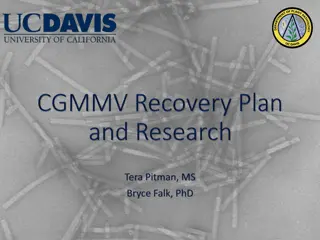Understanding BK Polyomavirus Infections in Pediatric Transplant Recipients
Explore the significance, pathogenesis, diagnostic work-up, and therapeutic approach to BK virus infections in pediatric bone marrow and solid organ transplant recipients, with a focus on kidney transplants. Learn about susceptibility factors, causes of immunocompromise, and specific antiviral treatment measures outlined in the American Board of Pediatrics content specifications.
Download Presentation

Please find below an Image/Link to download the presentation.
The content on the website is provided AS IS for your information and personal use only. It may not be sold, licensed, or shared on other websites without obtaining consent from the author. Download presentation by click this link. If you encounter any issues during the download, it is possible that the publisher has removed the file from their server.
E N D
Presentation Transcript
BK polyomavirus infections in pediatric transplant recipients A Pediatric Transplant Infectious Diseases Learning Module
Navigating the Modules DO NOT use your keyboard arrows or mouse click to advance slides Only use the navigation buttons on each slide these will keep you from getting lost If you do get lost, you can hit the home button any time to go back Unlabeled button types you might encounter: Previous slide Next slide First slide More information Return to decision choices
Using the Modules The modules are case-based, with decision points (branches) containing questions Many questions don t have right or wrong answers Click on a response (e.g. a diagnostic test), and you will find out more about it Multiple action buttons help you navigate The basic modules are designed to take about 45 minutes to complete You might take longer, especially if you choose to investigate all of the informational links provided (encouraged) Take your time and enjoy!
Overall Goals To understand the significance, pathogenesis, diagnostic work up, and therapeutic approach to BK virus infections in pediatric bone marrow transplant (BMT) and solid organ transplant (SOT) recipients, focusing on kidney transplant To review the American Board of Pediatrics (ABP) content specifications
Content Specifications Know the organisms to which a patient who has Know the organisms to which a patient who has undergone transplantation is most susceptible undergone transplantation is most susceptible (according to period of time post organ transplantation (according to period of time post organ transplantation and the site of infection) and the site of infection) Know the causes of immunocompromise that Know the causes of immunocompromise that contribute to susceptibility to infection in patients who contribute to susceptibility to infection in patients who have undergone transplantation have undergone transplantation Plan the initial evaluation and management of an Plan the initial evaluation and management of an immunocompromised transplant patient in whom fever immunocompromised transplant patient in whom fever or a particular focus of infection develops or a particular focus of infection develops Know specific antiviral treatment measures Know specific antiviral treatment measures
Content Specifications Understand the ability of the polyomavirus BK to Understand the ability of the polyomavirus BK to cause latent and chronic infection cause latent and chronic infection Understand the mode of transmission of polyomavirus Understand the mode of transmission of polyomavirus BK infection BK infection Recognize the clinical manifestations of BK viruses Recognize the clinical manifestations of BK viruses causing upper and lower urinary tract disease in causing upper and lower urinary tract disease in immunosuppressed patients immunosuppressed patients Recognize that treatment of renal disease caused by Recognize that treatment of renal disease caused by BK virus infection in transplant patients is primarily BK virus infection in transplant patients is primarily based on reduction of immunosuppressive therapy based on reduction of immunosuppressive therapy
BK Virus Module Learning Objectives BK nephropathy as a cause of chronic kidney disease after both BMT and kidney transplant BK associated with hemorrhagic cystitis and urinary tract obstruction, but not always nephropathy, after BMT The importance of viremia but not viruria as being more specific for clinical disease The role of reduction of immunosuppression in treatment
Background After SOT or BMT, immunosuppression is needed to prevent rejection of the graft or graft versus host disease Immunosuppression increases the risk for infections and malignancy On the next slide, we will first review commonly used transplant immunosuppressant medications, their mechanisms of action, and common and side effects
Agent Mechanism of Action Side effects Tacrolimus Calcineurin inhibitor blocking T cell activation/proliferation, resulting in prevention of NFAT activation hypertension, nephrotoxicity, neurotoxicity, lymphoproliferative disease, glucose intolerance, electrolyte disturbance (high potassium, low magnesium) Cyclosporine Calcineurin inhibitor blocking T cell activation/proliferation, resulting in prevention of NFAT activation hypertension, nephrotoxicity, neurotoxicity, lymphoproliferative disease, glucose intolerance, electrolyte disturbance (high potassium, low magnesium), hirsutism, gingival hyperplasia Sirolimus/ Everolimus mTOR inhibitor, inhibits cytokine driven T and B cell proliferation Mouth ulcers, hyperlipidemia, proteinuria, myelosuppression, poor wound healing, reproductive side effects Mycophenolate mofetil Blocks purine nucleotide synthesis, inhibits transcription Gastrointestinal side effects (nausea, diarrhea, weight loss), neutropenia Anti-thymocyte globulin (ATG) Depletes T cells and interferes with interaction of immune effector cells Cytokine release syndrome, myelosuppression Basiliximab IL-2 receptor antagonist, inhibiting activation of T cell signals Hypersensitivity reactions Alemtuzumab Monoclonal Ab against CD52 surface Ag, profound and prolonged lymphocyte depletion from circulation Cytokine release syndrome , ITP, lymphopenia, neutropenia Corticosteroids Anti-inflammatory Bone disease, weight gain, hypertension, cataracts, psychiatric
BK Virus Background BK virus is a small, non-enveloped, double stranded DNA polyomavirus BK virus establishes latency in uroepithelium after primary infection Reactivation or primary infection occurs in immunosuppressed patients after SOT or BMT and may result in nephropathy or hemorrhagic cystitis BK virus is generally asymptomatic in immunocompetent hosts, who therefore rarely have clinical disease
BK Virus Background Transmission is thought to be by respiratory or oral route, perhaps by a primary infection occurring early in childhood, with either mild upper respiratory symptoms, fever, or asymptomatic infection Due to its ubiquitous nature, the adult seroprevalence approaches 90% worldwide Donor screening pre-transplant does not include BK testing; seroprevalence is expected to be high In contrast to CMV, BK status of the donor, even if it were known, does not currently influence post- transplant care
BK Virus Screening Detection of the virus in the blood (viremia) is thought to be more specific for clinical disease than viruria Current screening protocols vary by center, but have included detection of the virus in the blood or urine by PCR, or in the urine, looking for decoy cells Detection of the virus in the urine, by either PCR or decoy cells, has lower specificity than viremia for biopsy-proven infection: To detect biopsy-proven BK virus nephropathy Sens Spec PPV NPV Decoy cells in urine 100% 71% 29% 100% Viremia by PCR 100% 88% 50% 100% Review Hirsch HH et al. N Engl J Med. 2002;347(7):488-96 Nickeleit V et al. N Engl J Med. 2000;342(18):1309-15 Review
CASE 1 A 5 year old male with a history of solitary right kidney secondary to left multicystic dysplastic kidney, developed end stage kidney disease at age 3 years due to focal segmental glomerulosclerosis He received a deceased donor renal transplant at age 3 years Induction immunosuppression included intraoperative alemtuzumab and a short steroid course. Maintenance immunosuppression included mycophenolate mofetil and tacrolimus Infectious prophylaxis included valganciclovir for CMV (donor and recipient CMV and EBV positive), trimethoprim-sulfamethoxazole (PCP) and nystatin (fungal)
How would you screen for BK virus infection in this patient? Quantitative plasma BK PCR Quantitative urine BK PCR
Correct Current kidney transplant guidelines recommend screening with plasma, not urine PCR testing, given the higher specificity of viremia for clinical disease Current kidney transplant guidelines suggest screening all kidney transplant recipients for BK virus with quantitative plasma PCR testing at least monthly for the first 3-6 months, then every 3 months until the end of the first-transplant year KDIGO clinical practice guideline for the care of kidney transplant recipients. American Journal of Transplantation 2009; 9(Suppl 3): S1 S157.
Incorrect It is common for transplant patients to have BK virus detected in the urine by PCR testing, even in the absence of disease Therefore, current recommendations suggest screening all kidney transplant recipients for BK virus with quantitative plasma PCR testing at least monthly for the first 3-6 months, then every 3 months until the end of the first-transplant year KDIGO clinical practice guideline for the care of kidney transplant recipients. American Journal of Transplantation 2009; 9(Suppl 3): S1 S157.
Back to Case 1: Back to Case 1: 4 months post-transplant, routine screening detects BK viremia with a plasma viral load of 3000 copies/mL. Creatinine is 0.5 mg/dL, slightly above baseline of 0.4 mg/dL
What is the next step in management? Repeat BK PCR testing in 2-4 weeks Kidney Biopsy
Case 1 Continued 9 months post-transplant, patient developed autoimmune hemolytic anemia (refractory to high dose pulsed steroids, IVIG trial and plasmapheresis). He required an urgent splenectomy He continues to have persistent BK viremia, with plasma PCR now 20,000 copies/ml 11 days after splenectomy, he presented with fever, decreased intake, and a serum creatinine that acutely increased from 0.46 to 1.39mg/dl over a 2 day period. No abdominal pain, dysuria or hematuria
What is the first priority for this patient at this time? Ultrasound of the kidney and bladder Kidney Biopsy
Incorrect A kidney biopsy is not without risks, given the acute rise in creatinine, evaluation for other causes of kidney dysfunction (calcineurin inhibitor toxicity, other nephrotoxins, dehydration, urinary infection, obstruction, etc.) is warranted at this time BK virus does not cause acute rises in creatinine, unless obstruction is present If creatinine dose not quickly improve, biopsy will be needed ASAP to rule out rejection
Correct Hydrate first, if creatinine improves, just observation Hydrate first, if creatinine improves, just observation Ultrasound to rule out post Ultrasound to rule out post- -operative obstruction operative obstruction Calcineurin inhibitor level to rule out acute toxicity Calcineurin inhibitor level to rule out acute toxicity Evaluation for urine infection, due to fever Evaluation for urine infection, due to fever
The creatinine returns to a baseline of 0.4 mg/dL after the patient recovers from his acute splenectomy surgery However, the creatinine slowly rises to 0.8 mg/dL over the next 8 weeks. Repeat PCR testing now shows persistent viremia 37,000-54,0000 copies/mL, on samples obtained several weeks apart What is the next step in management? Kidney Biopsy Treatment
CORRECT When plasma BK virus load >4 log 10 copies/mL or equivalent, renal biopsy with staining for BK virus and looking for the presence of viral inclusions are the gold standard in diagnosing BK nephropathy BK viremia precedes BK nephropathy by 1-12 weeks (10%), especially likely when viral loads exceed >10,000 copies/mL, (93% specificity for BK nephropathy) A slow rise in serum creatinine is an important indicator Hirsch HH et al. N Engl J Med. 2002;347(7):488-96 Nickeleit V et al. N Engl J Med. 2000;342(18):1309-15
Key point: Findings on biopsy can be focal, and therefore missed by sampling error, or easily confused with acute rejection, limiting biopsy as the gold standard Diagnosis of BK nephropathy: Intranuclear basophilic viral inclusions seen in uroepithelial cells on light microscopy and/or positive staining for SV40 antigen Nephropathy: Intranuclear inclusions Nephropathy: +Staining for BK virus Recommendations to obtain 2 or more core specimen biopsies, if possible, to avoid false negative samples and increase sensitivity Ramos E, Drachenberg CB, Wali R, Hirsch HH. The decade of polyomavirus BK-associated nephropathy: state of affairs. Transplantation. 2009 Mar 15;87(5):621-30. Review Review
Case 1 Follow-up Patient BK level peaked to 54,000 copies/mL after 3 weeks of initiating ciprofloxacin and reducing immunosuppression Ciprofloxaxin therapy for 10 weeks, then BK viremia had resolved No relapse in BK viremia from 14 months post transplant to date Unclear if the reduction in immunosuppression or ciprofloxacin caused resolution. More trials needed in this area to guide evidence-based management
Case 1 Conclusion Reported risk factors for BK viremia in renal transplant patients Overall degree of immunosuppression (likely most influential) Male gender Caucasian Older age Acute rejection Donor is BK or CMV positive Graft is from a deceased donor Ureteral trauma (stent placed at time of transplant) Diabetes mellitus Peak time for BK reactivation is ~ 3 months post transplant Hirsch HH, Randhawa P; AST Infectious Diseases Community of Practice. BK polyomavirus in solid organ transplantation. Am J Transplant. 2013 Mar;13 Suppl 4:179-88.
Case 2 Presentation A 17 year old female with a history of chronic myelogenous leukemia received a matched unrelated allogeneic hematopoietic cell transplant 2 months ago She develops gross hematuria with dysuria and the passage of clots in the urine Conditioning chemotherapy included busulfan, cyclophosphamide, and anti-thymocyte globulin. She is currently receiving cyclosporine for graft versus host disease prophylaxis Review of systems negative for fever, rash, back pain, or swelling of eyes/ankles. BP 110/75, no lower extremity edema
Case 2 Differential Diagnosis Bacterial urinary tract infection Cyclophosphamide toxicity Decker DB, Karam JA, Wilcox DT. Pediatric hemorrhagic cystitis. J Pediatr Urol. 2009 Aug;5(4):254-64. Adenovirus infection Polyomavirus infection Menstrual bleeding Glomerulonephritis Catheter related trauma Review Review
Case 2 Initial Evaluation Bacterial urinary tract infection Urine culture negative Menstrual bleeding Patient denies menses Glomerulonephritis BP normal, no edema, serum creatinine returns at 0.7 mg/dL, no RBC casts seen Catheter related trauma Thrombocytopenia is a risk, but patient has no catheter
How would you check for BK virus infection in this patient? Quantitative plasma BK PCR Quantitative urine BK PCR
Correct The urine BK PCR returns at 1 billion copies/ml In an immunosuppressed patient with unexplained gross hematuria and normal kidney function, a positive urine BK PCR is associated with a diagnosis of BK hemorrhagic cystitis
Incorrect With normal kidney function (creatinine 0.7 mg/dL) and symptoms specific to the lower urinary tract (dysuria, gross hematuria with clots), evaluation with urine PCR is first needed to check for adenovirus or BK virus-associated hemorrhagic cystitis
Over the next 2 days, the patients creatinine increases from 0.7 mg/dL to 2.1 mg/dL What is the next step in management? Ultrasound of the kidney and bladder Kidney Biopsy
Correct The ultrasound shows many clots in the bladder and bilateral hydronephrosis With a rapid rise in creatinine, urinary obstruction from either blood clots or urinary tract inflammation related to BK infection must be ruled out
Incorrect A kidney biopsy carries a very high risk of bleeding early after hematopoietic cell transplant, due to thrombocytopenia and commonly hypertension While kidney biopsy should always be considered in a patient with unexplained increases in creatinine, the rapid rise over 2 days points to the need to evaluate without biopsy first
Case 2 Revisited The patient s cystitis resolves with fluids and pain control and she no longer has gross hematuria Her creatinine returns to a baseline of 0.7 mg/dL after the cystitis resolves However, over the next few months, the patient s creatinine has gradually increased from 0.7 mg/dL to 1 mg/dL
How would you check for BK virus infection in this patient? Quantitative plasma BK PCR Quantitative urine BK PCR
Incorrect In a patient without urinary symptoms, a BK virus urine PCR is likely to be a non-specific indicator of infection After transplant, urine BK PCR testing is frequently positive in asymptomatic patients, likely due to viral shedding in latent phase, and of unknown clinical significance Save the $$$
Correct Less data is available in BMT recipients on the optimal screening and diagnostic approach to BK virus infection after BMT However, current kidney transplant guidelines/available literature suggests plasma BK virus PCR testing is more specific than urine PCR testing for clinically significant disease, especially in a patient without lower urinary tract symptoms (i.e. no hematuria or dysuria) KDIGO clinical practice guideline for the care of kidney transplant recipients. American Journal of Transplantation 2009; 9(Suppl 3): S1 S157.
Incorrect A kidney biopsy is not without risks in a transplant patient Given the BK PCR is at a relatively low level, close watchful waiting with evaluation for other causes of the mild kidney dysfunction (calcineurin inhibitor toxicity, other nephrotoxins, dehydration, urinary infection, obstruction, etc.) is warranted at this time
Correct With the relatively low grade BK infection (<10,000 copies/mL) on a single test, repeating the test in 2-4 weeks with close monitoring of kidney function is appropriate
BK virus PCR testing over the next few months shows persistent viremia 50,000-500,000 copies/mL and a creatinine now increased to 1.2 mg/dL What is the next step in management? Kidney Biopsy Treatment
Biopsy The diagnosis of polyomavirus nephropathy requires a kidney biopsy The risks and benefits of this procedure need to be weighed in transplant patients with clinical concern for nephropathy Indications for biopsy may include persistent elevations in plasma BK PCR testing with concomitant unexplained kidney dysfunction
Case 2 Follow-up Patient develops progressively worsening kidney function over the next 4 months, despite treatment with cidofovir, immunosuppression reduction, ciprofloxacin, and weekly IVIG She starts dialysis 7 months after her hematopoietic cell transplant secondary to end stage kidney disease from presumed BK virus nephropathy She passes away 3 months after starting dialysis
Treatment of BK nephropathy Reduce immunosuppression Cidofovir Leflunomide IVIG Fluoroquinolones Continue case 1 Kidney transplant Review Continue case 2 BMT Review
Reduce immunosuppression Should always be considered first-line therapy, when possible, balancing the risks of rejection/GVHD Mycophenolate often reduced first, but likely the net degree of immunosuppression, not the specific agent, is likely the highest risk factor Ginevri F, et al. Prospective monitoring of polyomavirus BK replication and impact of pre-emptive intervention in pediatric kidney recipients. Am J Transplant. 2007 Dec;7(12):2727-35. Hirsch HH, Yakhontova K, Lu M, Manzetti J. BK Polyomavirus Replication in Renal Tubular Epithelial Cells Is Inhibited by Sirolimus, but Activated by Tacrolimus Through a Pathway Involving FKBP-12. Am J Transplant. 2016 Mar;16(3):821-32.
Cidofovir Anti-viral properties against BK No randomized trials Case reports Clinical reports with mixed success Balance risks of nephrotoxicity, although has been used low-dose with probenecid Araya CE, Lew JF, Fennell RS 3rd, Neiberger RE, Dharnidharka VR. Intermediate-dose cidofovir without probenecid in the treatment of BK virus allograft nephropathy. Pediatr Transplant. 2006 Feb;10(1):32-7. Cesaro S et al. Relationship between clinical and BK virological response in patients with late hemorrhagic cystitis treated with cidofovir: a retrospective study from the European Group for Blood and Marrow Transplantation. Bone Marrow Transplant. 2013 Jun;48(6):809-13.























